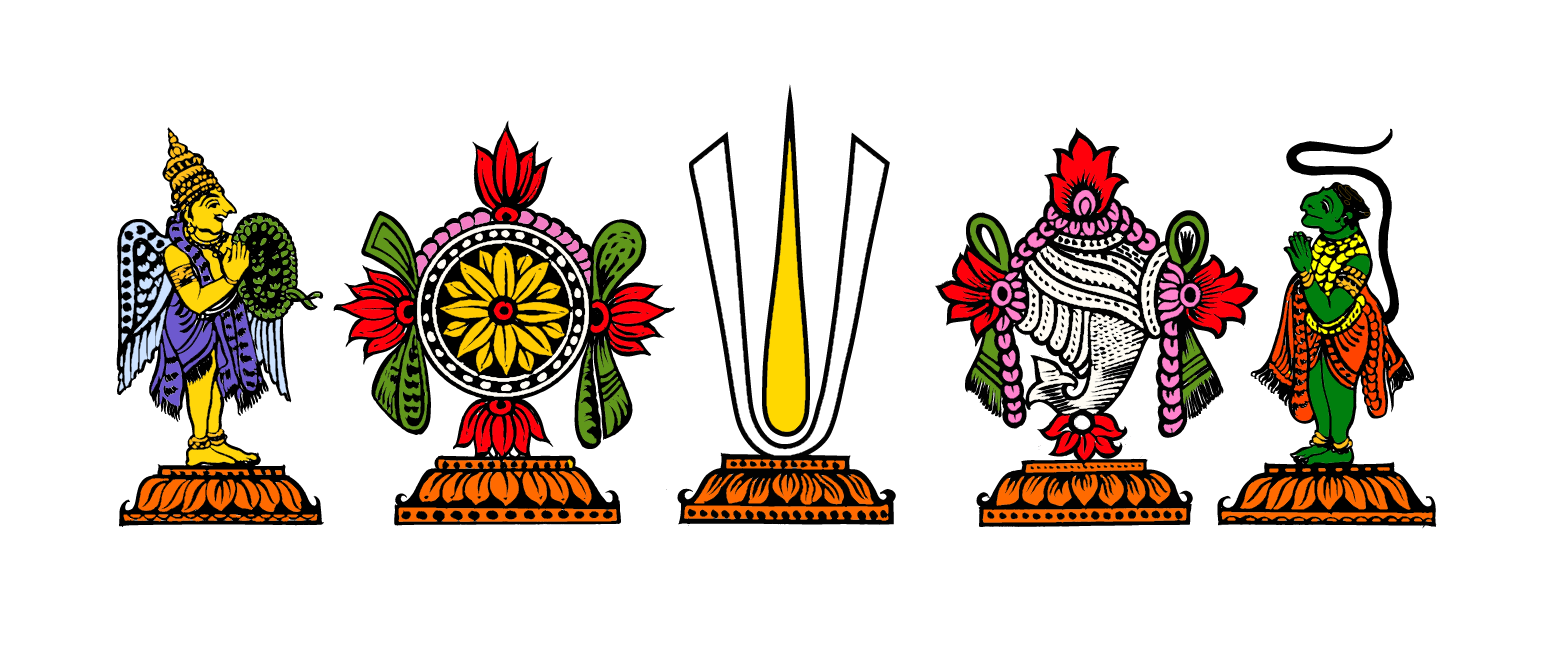
Our Previous Acharyas
Srimad ThirukKudanthai Desikan
Thirunakshatram: Purattasi Puradam (Purva Ashadha)
śrī kṛṣṇa-deśika-padāmbuja bhṛñga-rājaṁ
vedānta lakṣmaṇa-munīndra kṛpātta-bodhaṁ
traiyanta-deśika yatīndra śaṭāri-mūrtiṁ
gopāla-deśika śikhāmaṇiṁ-āśrayāmaḥ
“We seek refuge and offer prostrations unto Sri Gopalarya Mahadesikan (Thirukudanthai Desikan), who is like a bee hankering for nectar at the lotus feet of his acharya and father, Srimad Krishna Desikan, from whom he undertook his pancha-samskaram (five-fold initiation into Sri Vaishnavism) and veda-adhyayanam (study of Vedic texts); who absorbed the essence of ubhaya-vedanta from Srimad Sakshat Swami Sri Vedanta Lakshmana Muni; and who is an embodiment of three great acharyas: Srimad Vedanta Desikan, Bhagavad Ramanuja and Swami Nammazhwar.”

Sri Thirukkudanthai Desikan who is also known as Srimad Gopalarya Mahadesikan is the reviver of the Munitraya sampradayam, which owes it origins to Sri Natha Muni, Sri Yamuna Muni and Sri Ramanuja Muni through the line of Srimad Vedanta Desikan. For this reason, Srimad Gopalarya Mahadesikan was awarded the title ‘Thirukkudanthai Desikan’ and another title, ‘Munitraya Sampradaya Pravartakar’ by the presiding Deity or the divya-desam perumal of Thirukkudanthai, Sri Aravamudan Himself.
His avataram (divine birth) took place in the year 1700 CE in the Vedic year of Vikrama in the Tamil month of Purattasi under the star Pooradam in Athreya gothram in the lineage or vamsam of Sri Appullar.
Sri Appullar was Srimad Vedanta Desikan’s maternal uncle, and a descendant of one of Bhagavad Ramanuja’s direct disciples, Sri Kidambi Achan.
Sri Kidambi Achan was also known as Madapalli Achan, because he was charged with the kainkaryam (service) of cooking in the madapalli (sacred kitchen) of Bhagavad Ramanuja.
Srimad Thirukkudanthai Desikan’s father Sri Kidambi Krishna Suri had named him Gopala Desikan at birth. Gopala Desikan received his pancha-samskaram and veda-adhyayanam from his father. He also learnt tarkam, vyakaranam, mimamsa, Divya-prabhandham, Desika-prabhandham and Desika-stotrams from his father, and thus became an erudite scholar.
Sri Gopala Desikan requested the great Vaishnavite preceptor Sakshat Swami to bless him and shelter him as a sishya (disciple). Sakshat Swami was immensely pleased after testing his disciple’s jnanam (spiritual knowledge), anushtanam (sacramental practices) and bhakti (devotion to the Lord), and accepted him as a sishya.
Sri Gopala Desikan studied Srimad Rahasyatraya Saram, Sri Bhashyam, Gita Bhashyam, Sri Pancharatra Pravrutti, Anushtana Granthas, Srutaprakasika, Tatparya Chandrika, Shatadushani, Tattva-mukta- kalapam, Nyasavidya-darpana and Sri Tattva-siddhanjanam under the holy feet of Sakshat Swami.
Sakshat Swami instructed Sri Gopala Desikan to learn Bhagavad-vishayam ( the Irupathi-nalayira-padi commentary on the Thiruvaimozhi of Sri Nammalwar) from his disciple Sri Paduka Sevaka Ramanuja Muni, to whom he had already taught the commentary. As instructed, Sri Gopala Desikan studied Bhagavad-vishayam from Paduka Sevaka Ramanuja Muni and became a scholar in that too.
Finally, he prayed to Sakshat Swami and requested him for bhara-samarpanam or ritual surrender. Sakshat Swami was pleased at his request and performed bhara-samarpanam for Sri Gopala Desikan at the sacred feet of Lord Sri Ranganatha through the process known as acharya-nishtai.
When he offered prayers with one of his compositions, Aparyapamrita Dhyana Sopanam, to the Deity of Sri Aravamudan at Thirukkudanthai, the Lord Himself appeared through the archakar (the priest) and awarded him the name, ‘Thirukkudanthai Desikan’.
He composed many works including Ahnika Grantham, Sri Desika Sahasranamam, Nikshepa Chinthamani (also known as Sharanaagati Shastra Vivaranam), Sangraha Vyakyanam (collective commentaries) for Kanninun Siruththambu and Thiruppallandu, Sri Jayanti Nirnayam, Aparyatamrita Dhyana Sopanam on Aravamudan (similar to Bhagavad Dhyana Sopanam of Srimad Vedanta Desikan on Lord Ranganatha).
One day Lord Aravamudan appeared in a dream and informed Srimad Thirukkudanthai Desikan that three yatis (renunciates) who were the amsha-avataras (partial incarnations) of Sri Nathamuni, Sri Yamuna Muni, and Sri Ramanuja Muni would arrive with a request to become his disciples. The Lord further instructed him to accept them as his sishyas and teach them the esoteric mysteries and teachings of the Munitraya sampradayam, established and passed down by the three great munis: Nathamuni, Yamunamuni and Ramanuja Muni.
Similarly, the Lord appeared in the dream of the three swamis and told them to accept sannyasa or the renounced order, and proceed to Thirukkudanthai to become disciples of Srimad Thirukkudanthai Desikan.
The three Swamis were:
- Sri Srinivasa Mahadesikan of Cheyyanam on the banks of river Thamirabarani
- Sri Ranganatha Mahadesikan of Vathiyairuppu, Thirumaliruncholai near Madurai
- Sri Vedanta Ramanuja Mahadesikan of Vazhuthur, a small village near Thirukkudanthai.
Srimad Thirukkudanthai Desikan accepted all three as his sishyas and taught them the sampradaya-granthas through the process of kalakshepams.
One day during the satrumurai ritual conducted during the festival of Adhyayana Utsavam, when Srimad Thirukkudanthai Desikan was chanting mangalasasanam prayers, accompanied by his three disciples at the shrine of Aravamudan, the Deity form of the Lord Himself spoke to them and awarded him the title ‘Munitraya Sampradaya Pravarthakar’.
Srimad Thirukkdanthai Desikan instructed his three disciples to return back to their places and conduct sampradaya-pravachanams or traditional-preaching from their respective places. Of these three disciples, it was Srimad Vedanta Ramanuja Mahadesikan, who was chosen to adorn the Andavan Ashramam acharya-pitam as the first acharya, and was called Srimad Vazhuthur Andavan.
Srimath Thirukkudanthai Desikan accepted the sannyasa order at the age of 81 years (in the year called Plava in 1781 CE, in the month of Karthigai on the tithi of Krishna-panchami when the star Karthigai was in ascension) with the name Aparyaptamrita Mahadesikan. The very next day, on Krishna-sashti tithi, he departed to adorn Thirunadu under direct instructions from the Lord Himself.

